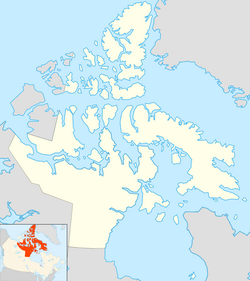Killiniq, Nunavut
|
Killiniq Kikkertaujak; Killipaartalik |
|
|---|---|
| Coordinates: 60°25′00″N 064°50′00″W / 60.41667°N 64.83333°WCoordinates: 60°25′00″N 064°50′00″W / 60.41667°N 64.83333°W | |
| Country | Canada |
| Territory | Nunavut |
| Region | Qikiqtaaluk Region |
| Population (after 8 February 1978) | |
| • Total | Uninhabited |
Killiniq (meaning: ice floes) (previous spelling: Killinek; local variants: Killipaartalik or Kikkertaujak (peninsula); previously: Bishop Jones' Village; sometimes referred to as: Port Burwell) is a former Inuit settlement, weather station, trading post, missionary post, fishing station, and Royal Canadian Mounted Police post on Killiniq Island. Previously within Labrador, and then the Northwest Territories, it is now situated within the borders of Nunavut.
Killiniq, the settlement, is located on Killiniq Island, situated in Ungava Bay at the extreme northern tip of Labrador. The island contains the only land border between the territory of Nunavut, to the west, and the province of Newfoundland and Labrador, to the east.
The settlement developed around Port Burwell harbour, located at the mouth of Hudson Strait. It is surrounded by coastal cliffs of an otherwise barren and rocky island, and a sea, frozen almost year-round.
Though there is an abundance of seal, walrus, and Arctic char that promoted habitation, the settlement area is bereft of trees and wood. Some brushwood is scattered amongst stones. Wildflowers and moss are found nearby, but berries are located miles further afield.
The Killiniq locality appears as early as 1569 on a Mercator map. It was visited in 1587 by John Davis, and in 1602 by George Weymouth.
Approximately 6 mi (9.7 km) south of Killiniq, Alpheus Spring Packard, the American entomologist and palaeontologist, discovered the remains of an Inuit settlement.
...
Wikipedia

